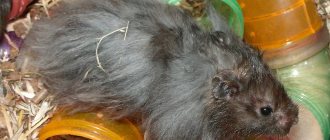Hygiene procedures
Like other furry pets, the hamster needs hygiene procedures. Long-haired cats require daily grooming
It is important to regularly clean the skin from dirt
Bathing
You can bathe pets only in exceptional cases, using a special shampoo. Water procedures are a stressful situation for animals, since they are quite clean and constantly wash themselves.
It is recommended to place a container with dry sand in the cage, in which the animal will clean its fur. When fleas appear, you should wash your hamster with an antiparasitic agent, applying it with gentle movements to the surface of the body.
Dry cleaning of fur.
Nail care
Particular attention should be paid to the claws. They need to be regularly ground down, because with a sedentary lifestyle and the onset of natural old age, they grow to such an extent that the hamster cannot walk normally
Pet nutrition as a guarantee of health
Photo from filearmy.s3.amazonaws.com
A hamster's diet consists primarily of grains, but it also requires fruits (apples, persimmons, pears, peaches and bananas) and vegetables (zucchini, turnips, lettuce, carrots and radishes). But it is better to exclude white cabbage or onions. Nuts (walnuts and peanuts) will also be useful for your pet, but not almonds - their peel contains substances that are dangerous to the animal. You should not feed him citrus fruits or chocolate.
Periodically, your pet needs to be given protein food. Two or three times a week you can give the animal low-fat cottage cheese, boiled eggs or chicken breast. Pay attention to what the little furry hides in his bins. There should be no perishable food there, as the pet may get poisoned. Despite the myth that hamsters can survive as long as they want using their cheek pouches, they will only survive 2-4 days without food or water.
If you use hay instead of litter, don't be surprised if your hamster will chew it too.
Some people buy a special chalk so that their pet can receive useful minerals and grind down rapidly growing teeth. Sometimes hamsters need additional vitamins, but here it is necessary to consult a specialist.
Failure to study the main signs and symptoms of diseases
It is imperative to know the symptoms of certain diseases. After all, prevention is the best treatment. A timely visit to the veterinarian can save your pet and help avoid many problems.
It is worth paying attention to changes in the behavior of your furry pet. Reasons for concern may include:
- excessive activity and lack of sleep;
- lethargy;
- lack of appetite;
- sadness.
If you find this, be sure to contact a specialist.
Why does a rodent drink a lot of liquid?
If your pet's need for water has sharply increased, and the hamster begins to drink a lot of liquid, then you need to think about a change in behavior.
- Changes in temperature and humidity in the room. The ideal temperature is considered to be up to +22 degrees. For favorable wakefulness, it is better to move the cage with the animal to a cool place.
- Damage to the drinking bowl. It is necessary to check the connections for integrity and replace them in case of leaks.
- Changing the diet or quickly introducing a new food. It is advisable to switch to a new type of food gradually. Adding salty foods can also be a source of thirst.
If there are no changes in the activity of the rodent, then the appearance of kidney disease and the development of diabetes are possible . The main signs are:
Can hamsters have cheese?
- Eating more food.
- Rapid weight loss or obesity.
- The ruffled pose of the animal.
- Irritability and increased activity.
- Increased sleep duration.
- Frequent urine discharge, possibly with the smell of nail polish.
When your hamster drinks the weekly amount of water, you must show the animal to a doctor and begin a course of treatment.
Bowl or sippy cup?
The daily drinking rate for a healthy rodent is 5-15 ml of water per 100 g of body weight. Using a bowl can cause constant tipping and puddles inside the cage. Litter, feces and food can also spoil the taste of the water if you use the bowl as a reservoir. The optimal solution for the animal is a water bottle.
A drinking bowl attached to the walls of the enclosure saves space and easily trains the animal to drink. When you press the valve or ball at the end of the spout, water drips into the rodent's oral cavity. Most animals determine the source of moisture themselves, but sometimes help is required. Just splash a drop of water on your pet's nose.
Lifespan
In nature, dzungarians live relatively short - 1.5-2 years. Under natural conditions, small and defenseless hamsters face many dangers. They are often attacked by predatory animals and die due to various diseases, hypothermia or lack of food.
At home, things are different. With care, attention and a favorable environment, they can live up to 3 years. Some representatives of the breed live up to 4 years.
In nature
Under favorable conditions, Djungarian hamsters live in nature for about 2 years. However, most of them do not live to that age. In natural conditions, life expectancy directly depends on the dangers that lie in wait. Every day rodents leave their holes and go in search of food. During such outings, extreme caution is required. Every day a hamster's life is exposed to danger and stress.
Even if the dwarf is in a hole with a lot of food, it cannot relax either. The rodent's heart cannot withstand the stress it experiences and it dies. In addition to nervous strain, life expectancy is affected by attacks from predators, low temperatures, diseases, and injuries.
At home
At home, Djungarian hamsters have a much easier and simpler life - not only mentally, but also physically. The benefits of living at home add additional years of life to the animal, as a result of which they can live up to 4 years.
However, the lifespan of a pet hamster is influenced by the quality of maintenance and care, love and care of the owner. The better the conditions of detention, the longer the dzhungarik will delight its owner with its love. Before you get yourself a small pet, you need:
- Create optimal conditions of detention.
- Provide proper care.
- Create a balanced diet
- Protect the rodent from stress.
At what age is it better to buy
This is a very important question. How much joy and positivity the rodent will bring you depends on how correct the answer you find to it depends.
At the same time, it is not advisable to take hamsters older than 1 year. These are already older individuals - they move little and sleep more. Of course, for a child, watching the house in which his pet sleeps will not bring too much joy.
As for the rest, you must decide for yourself. But most breeders try to buy young rodents - they are cheerful, active and playful. Plus, thanks to their youth, they will spend more time with you. But for fast-living hamsters, every month is a whole era.
Using the wrong bedding
In order for a hamster to feel comfortable and please its owners with its healthy appearance and active games, it needs to choose the right food, change the water often and use the right litter for the cage.
You can find a lot of bad advice on numerous forums on the Internet. For example, that rodents love rags. Bury yourself in them and live there. However, this is not at all true. The rags will quickly absorb dirt and become unhygienic. Besides the fact that it will emit an unpleasant odor, and aromas are important for hamsters.
Additional recommendations
Hamsters begin to age at 15 months of age. This is reflected in the deterioration of the health of their heart, respiratory and digestive systems, and teeth. To avoid a decline in quality of life, from this age more vitamins and mineral baits need to be introduced into the hamster’s diet.
Hamsters are nocturnal animals, so it is advisable to communicate with them closer to the dark - in the morning or evening. It is undesirable to disturb an animal during the day or disrupt its sleep pattern - this leads to aggression and health problems.
Algorithm
The fluffy miracle, seeing the drinking bowl for the first time, does not understand what kind of object it is and what it is intended for. Your task is to introduce him to this useful thing and teach him how to use it. Stick to the following plan:
- Place a water bowl inside or outside the cage. Pay special attention to the height of the spout. The animal must be able to reach it freely.
- Wait a couple of hours and watch the animal, suddenly the hamster becomes interested and touches the ball with its nose. In this case, he himself will understand how to use the drinking bowl.
- If the animal has not shown interest, you will have to train it. To do this, place the hamster near the hole and press the ball with your finger. A droplet will hang on the metal spout. The moisture will remain on your finger; lightly run it over your pet’s nose. After this, you can bring the animal to the tube and lightly touch the ball with its muzzle.
There is another interesting way: you need to lubricate the nose with some yummy food. Khoma, attracted by the pleasant smell, will try to chew the rod, some water will get into his mouth - and he will understand what this thing is for.
Now you know why a hamster doesn't drink water. By following our recommendations, you will quickly accustom your pet to drinking water. The main thing is to remember to change the water in it often.
Source
Feeding frequency
It's funny to watch the animal eat, but the optimal time is to feed once in the evening when the animal is active. Another acceptable option is feeding in the evening and early morning hours, before the animal naps during the day. The evening portion should be significantly larger than the morning portion.
Having decided on a schedule that is convenient for themselves, it is better for the owner to stick to one feeding time. With amazing accuracy, the animal will wait for dinner at the appointed time. This stability is beneficial for the rodent's digestion.
Due to the high metabolic rate, the hamster cannot tolerate hunger strike at all. It is difficult to answer unequivocally how many times a day a hamster should eat.
Although the main meal occurs at night, the animals like to wake up during the day to have a snack. Therefore, access to food should be available almost around the clock.
When it comes to how often you should feed your hamster, it is important not to overdo it. You cannot give food more than twice a day: this will disturb the animal’s sleep. Juicy and protein foods can spoil if the hamster does not eat it right away. For the same reason, inventories are regularly inspected, removing spoiled products.
Cell selection
A cage with vertical or horizontal bars is the most suitable and comfortable home for a hamster. Its size depends on the breed of hamster. For dwarf hamsters - Djungarian and Roborovsky - the height and width are approximately 30 cm, length - 50 cm. For golden or Syrian hamsters, it is better to choose a larger cage - 40 cm wide and high, about 60 cm long.
Unlike Syrian hamsters, Djungarian and Roborovian hamsters are indifferent to climbing rods and other acrobatic tricks, so plastic cages (dunes) are quite suitable for them. Under no circumstances should hamsters be placed in tall and narrow aquariums - bacteria multiply very quickly here, there is high humidity and there is almost no access to fresh air.











